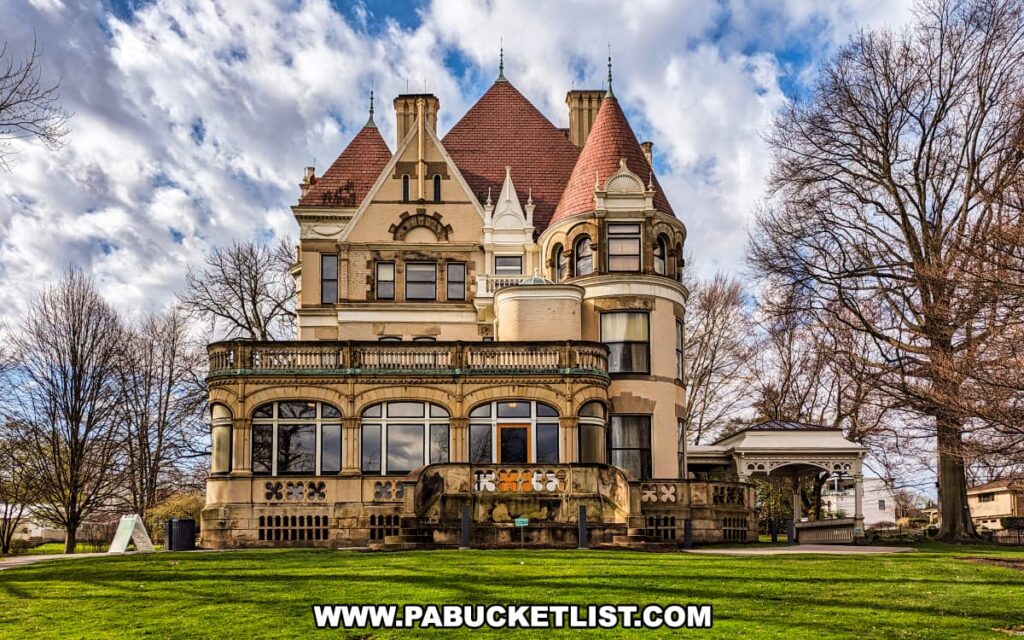
The Henry Clay Frick estate offers a glimpse into the lavish Gilded Age lifestyle of one of Pittsburgh’s wealthiest families in the late 19th century.

The estate is a testament to the life and times of Henry Clay Frick, a titan in the Pittsburgh steel industry, and whos aggressive business tactics played a significant role in the infamous 1892 Homestead strike.

This violent labor dispute at the Homestead Steel Works, which Frick managed for Andrew Carnegie, became a pivotal moment in American labor history.

The conflict between striking steelworkers and private security agents resulted in numerous deaths and injuries, casting a shadow over Frick’s legacy.

Today, the estate stands not only as a monument to American industrialism and wealth but also as a witness to the era’s tumultuous labor relations.

Directions | Hours | Admission Fees
The Henry Clay Frick Estate is located at 7227 Reynolds St, Pittsburgh, PA 15208.
The grounds at the Frick estate are open Tuesday through Sunday from 8AM until dusk, free of charge.

Tours of Clayton, the mansion on the grounds of the Frick estate, are given at specific times Tuesday-Sunday.

There IS a fee to tour the mansion, ranging from $12 to $22 dollars for a 75 minute guided tour, and you can find the specifics on admission fees on the Frick estate’s OFFICIAL WEBSITE.

There is NO FEE to tour either the Car and Carriage Museum or the greenhouse, both also located on the Frick estate grounds.

What You’ll See at the Henry Clay Frick Estate
Touring the Henry Clay Frick Estate in Pittsburgh encompasses several structures and museums, each a fragment of the grandeur and historical significance of the Frick family’s legacy.

Clayton
At the heart of the estate is Clayton, the meticulously restored Frick family mansion.

This Victorian-era masterpiece, dating back to the late 19th century, showcases the family’s domestic life and their affluent tastes.

Visitors to Clayton can wander through rooms replete with period furniture and décor, offering a firsthand experience of the luxury the Frick family enjoyed.

What you CAN’T do is take pictures inside the mansion – it’s prohibited.

Fortunately, the Frick estate has produced a professionally-filmed and narrated YouTube video tour of the inside of Clayton (which I’ve linked to below) – it gives you a beautiful view and description of what you’ll see on the tour.
The Car and Carriage Museum
The Car and Carriage Museum (open 10AM-5PM), also part of the estate, is a haven for automobile enthusiasts.

It exhibits a remarkable collection of vintage cars and carriages (some owned by the Fricks, others donated to the museum), illustrating the evolution of transportation and its impact on American society.

The Greenhouse
The estate’s greenhouse (open 10AM-5PM) further complements the experience, showcasing an array of plants and flowers that demonstrate the family’s horticultural interests.

Visitors can stroll among lush flora that fills the air with the fragrance of blooming life.

The Playhouse
Not to be overlooked is the Playhouse, once a joyful haven for the Frick children and their elaborate playtimes.

Although it’s not currently open to the public, its presence on the estate serves as a reminder of the family’s more personal history and the childhood pastimes of the era.

The Visitor Center
The Grable Visitor Center (open 10AM-5PM) serves as the welcoming hub for guests.

This modern facility seamlessly integrates into the estate, providing information and housing the Museum Store.

The Frick Art Museum
The Frick Art Museum on the estate is said to house a splendid array of artworks collected by the Fricks. Unfortunately the museum was closed in preparation for a new exhibition at the time of my visit, so I can’t comment on what it’s like inside – I’ll update this article when I have a chance to personally tour the museum in the future.

Final Thoughts
The Henry Clay Frick estate is not just a journey into the past; it is a multidimensional narrative that speaks of industrial triumph, personal luxury, and the complex tapestry of American history.

If the opulence, art, and architecture of the Gilded Age in America interests you, the Henry Clay Frick estate in Pittsburgh is a time capsule well worth exploring!

Nearby Attractions
25 Must-See Attractions in Allegheny County is your guide to more of the best things to see and do in and around Pittsburgh.

Did you enjoy this article?
If so, be sure to like and follow PA Bucket List on Facebook, Instagram, and/or Pinterest to learn more about the best things to see and do in Pennsylvania!
Click on any of the icons below to get connected to PA Bucket List on social media.


